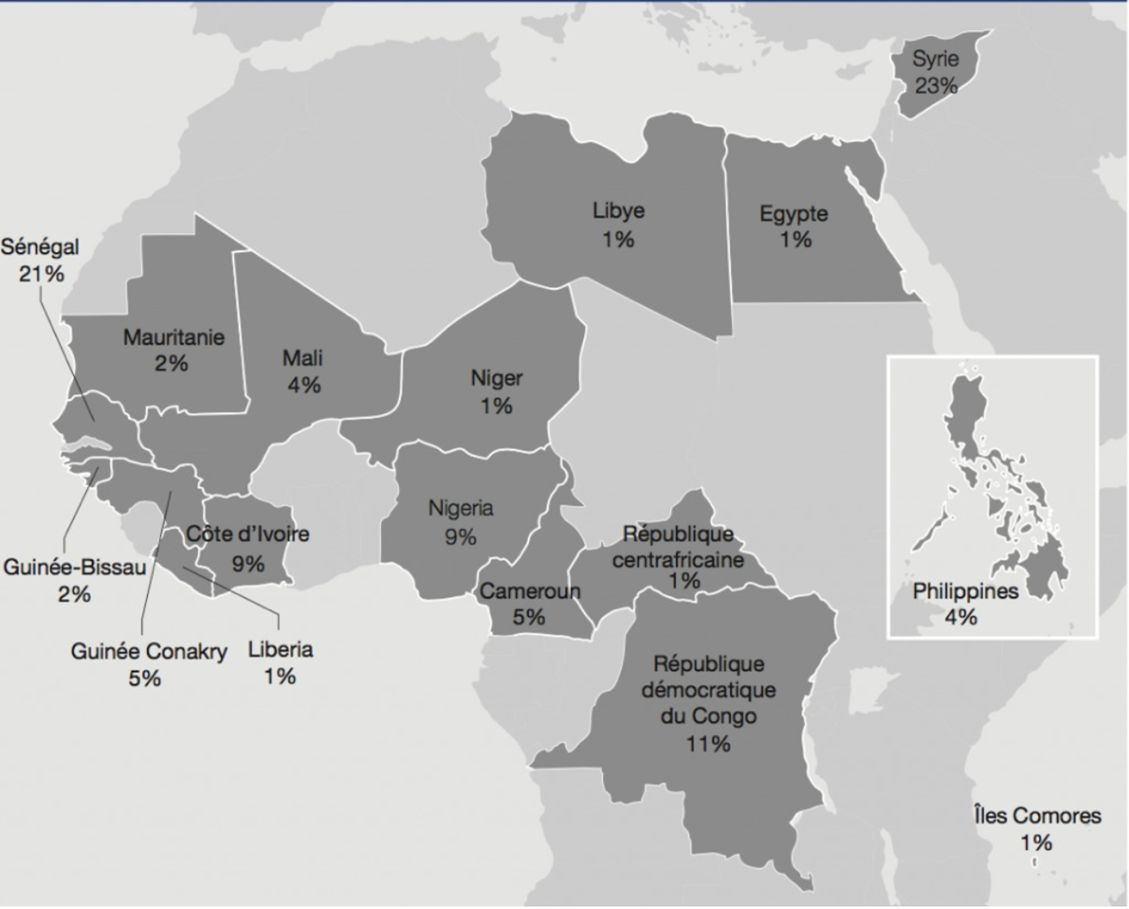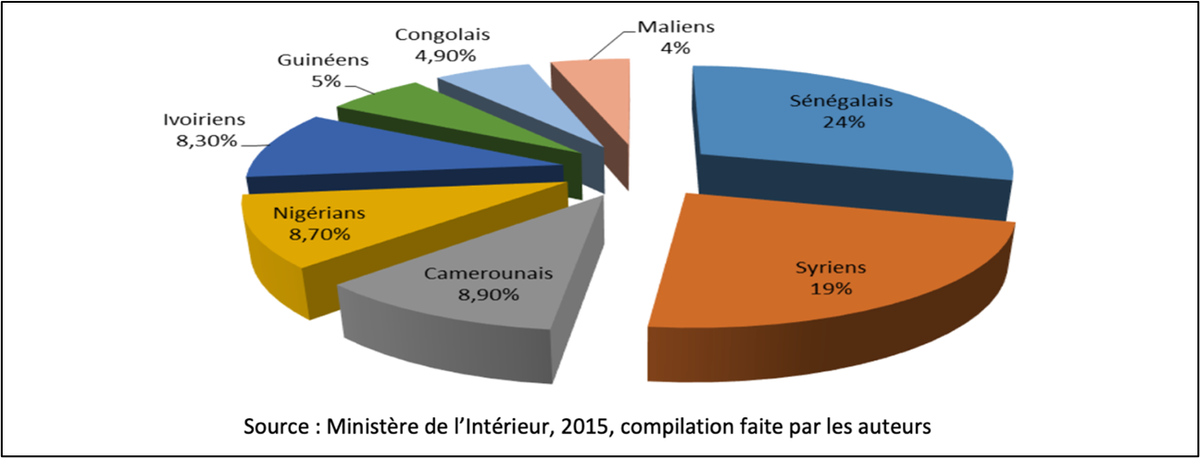Regularisation Campaigns in Morocco and their numbers: between ambiguity and ambivalence.
Mehdi Azdem, chercheur indépendant en communication et ingénierie culturelle & Abdeslam Ziou Ziou, chercheur et consultant indépendant en arts et culture (Casablanca, Maroc), 11 ديسمبر، 2023
As part of the National Strategy for Immigration and Asylum (SNIA), two regularization campaigns for migrants and refugees were implemented between 2014 and 2017.
"Sincerity leads to accuracy" Gao Xingjian
Introduction
As part of the National Strategy for Immigration and Asylum (SNIA), two regularization campaigns for migrants and refugees were implemented between 2014 and 2017. Several public and international entities put forward figures, different from each other, on these two campaigns, in which the objective was to issue residence permits to foreigners on Moroccan territory. We will try to answer the questions below to understand the discourse around these two waves of regularization and to qualify the figures communicated – on sub-Saharan migrants - to discern the practical impact of these campaigns on the migratory situation in Morocco.
Our questions are as follows:
1- What are the different sources of information? And why this differentiation in the figures of the two regularization waves?
2- What are the profiles of migrants and refugees who received residence permits between 2014 and 2016/2017?
3- How many sub-Saharan migrants are we talking about in the context of the two regularization campaigns?
The stakes of the figures of the two regularization campaigns in Morocco:
First regularization campaign (2014)
Following the implementation of the SNIA, the first concrete action of this strategy was the operationalization of the regularization campaign in 2014. This activity took place between January and December 2014, and ended with the granting of thousands of residence permits to foreigners in Morocco. In February 2015, the president of the CNDH – the National Council for Human Rights –announced that 27,130 applications had been submitted to foreigners' offices and that 16,180 had received favorable responses[1], while the Minister Delegate for the Interior announced at a press conference held on February 9, 2015, that 17,916 applications were accepted out of a total of 27,332 applications filed[2]. A few months later, the then minister in charge of migration and African policy announced the regularization of 18,694 people (without considering those regularized after appeals) in September 2015[3].
Today, we find other figures on the official website of the Ministry in charge of migration[4]. It indicates that this first campaign made it possible to give a favorable response to 23,056 requests out of the 27,649 filed, i.e. a regularization rate of 83.53%[5]. This inaccuracy of the figures creates discomfort in the processing of cases of regularization, because beyond the quantitative aspect, it is also a question of bringing together the nationalities of the beneficiaries of the administrative regularization of their status, either migrants or refugees.
According to information from the Ministry of Foreign Affairs, African Cooperation and Moroccans Living Abroad[6], we find - at the top of the list of regularized people[7] - Syrians (23%), Senegalese (21%), Congolese (11%) then other nationalities – Mauritanians, Liberians, Libyans, Egyptians, Guineans, etc. – representing 1% or 2% of the target public for regularization.
According to the official portal of the Kingdom of Morocco[8], the total number of nationalities having benefited from this first operation amounts to 118 nationalities. Report by GADEM (Groupe Antiraciste de Défense et d’accompagnement des Étrangers et Migrants) and the International Federation of Human Rights Leagues, entitled "Morocco between raids and regularizations, assessment of an indecisive migration policy"[9] dating from March 2015 indicates percentages different from those displayed on the Ministry website. It draws these data sources from an official statement[10] by the Minister of Migration Affairs, that says that the Senegalese (27%) are at the head of this operation, followed by the Syrians (18.4%) and the Congolese (5.8%)[11].
Based on the sources of the report by the Moroccan Association for Studies and Research on Migration (AMERM) and the Population, Migration and Environment Foundation (PME), entitled “The immigration policy. A milestone in Morocco's African policy? Case of the regularization of sub-Saharan migrants” [12] provides new figures from the Ministry of the Interior. Senegalese come first among sub-Saharan migrants who have filed a request for regularization. Indeed, they represent 24% of the total number of applications filed, followed by Syrians (19%) and Congolese (4.90%)[13].
This regularization campaign was characterized by the presence of sub-Saharan migrants who represent more than 13,000 out of 27,000 regularization files, or about 50% of the total number of files submitted[14]. Despite these efforts, sub-Saharan migrants continue to be forcibly displaced on Moroccan territory. In February 2015, the Moroccan military raided the forests surrounding the Spanish enclave of Melilla, arresting around 1,200 people who were then moved to central and southern Morocco.
Second regularization campaign (2016/2017)
On December 12, 2016, King Mohammed VI announced the launch of a new campaign to regularize irregular migrants. On March 8, 2017, the Minister responsible for migration at the time revealed that 18,281 requests for regularization of foreigners in an irregular situation had been filed at the national level[15]. According to the CNDH[16], 28,400 files submitted from 113 nationalities (between 15/12/2016 and 31/12/2017) with a regularization rate exceeding 90% of requests.
Sara Benjelloun's study[17] reveals that this second wave allowed 23,096 people to be granted registration cards issued out of a total of 27,649 regularization requests. By cross-referencing the data provided by the CNDH (more than 27,000 requests filed and a regularization rate of 92%), we can deduce that more or less 25,000 people have been regularized, which is more than the figure announced by the MCMREAM[18].
As of October 5, 2017, 24,367 regularization applications have been filed by irregular migrants in 70 provinces and prefectures of the Kingdom. These applications were filed mainly by nationals of Senegal (24%), Côte d'Ivoire (18%), Syria (7%), Guinea Conakry (6%) and Cameroon (6%). Rejected requests were to be examined by the national appeals commission chaired by the National Human Rights Council[19].
Indeed, the question of the regularization of migrants and refugees between the two operations of 2014 and 2016/2017 enabled more than 50,000 people to justify a legal status on Moroccan territory. The problem lies in the renewal of these residence permits since these campaigns are based on an interministerial agreement and not on an organic law. As one of the people interviewed – a journalist – demonstrated to us in the context of this study: "We have encountered many problems, for example the migrants who were regularized in 2014 and 2016. 50,000 people have a big problem, they do not want to renew their papers, for the simple reason, because these people, when they regularized the situation of these migrants, they based their decision on an agreement between the Ministry of the Interior and the Ministry of Migration, it is an agreement that cannot be considered as law”.
The journalist added that the authorities and politicians make no distinction between migration and migrations with reference to the origins of the nationalities of foreigners in Morocco, and said: “Migrants are not only sub-Saharans (…), we are not talking about one migration but about many migrations, for example, when we take the categories of migrants in Morocco, we find those who come from sub-Saharan Africa. People who come from France, England, Spain, Algeria, Tunisia, Yemen, Palestine…we find a mosaic. According to the Ministry of the Interior, the regularization of 2014 and 2016, there are 113 nationalities; including 17 nationalities from sub-Saharan Africa (…) The SNIA is only for sub-Saharans, because according to the Ministry of the Interior still, the others do not pose a problem”.
Conclusion
Following the two waves of regularization which benefited 50,000 people, could we judge that this action could help these migrants in their daily life in Morocco?
Based on the figures of the last general census of inhabitants in Morocco dating from 2014, the number of foreign people residing in Morocco was 82,206[20], or 0.24% of the Moroccan population which was 33,760,000. The number of sub-Saharan migrants in an irregular situation who requested the regularization of their status in 2014 was 13,000 people (i.e. 0.04% of the Moroccan population). These figures remain relatively very low compared to attempts by migrants – across all Mediterranean countries – to cross to Europe, which amounted to 207,000 attempts in 2014.
A national survey on forced migration in Morocco published by the HCP – Haut-Commissariat au Plan – in 2021, informs us that more than one in three migrants (31.9%) is aware of the campaigns carried out by Morocco to regularize their situation, slightly more among refugees (37.9%) than among other migrants (29.7%). Awareness of the existence of these regularization campaigns is most widespread among migrants from the Democratic Republic of Congo (41.2%) and least common among those from Guinea (22%)[21].
Several factors have allowed the regularization or not of migrants and refugees in Morocco between 2014 and 2017. Today, former holders of the residence permit are still struggling to renew their permit despite all the efforts made by all stakeholders of the SNIA.
Annex 1:
Breakdown by nationality of people regularized during the first campaign.

Source: Ministry of Foreign Affairs, African Cooperation and Moroccans Residing Abroad
Annex 2:
Breakdown by nationality of people regularized during the first campaign.

Sources: CNDH and statement by the Minister for Migration Affairs before the House of Representatives on December 2, 2014.
Annex 3:
Breakdown by nationality of applications submitted by irregular migrants during the first campaign.

Bibliography
Moha Ennaji, Jean-Marie Simon, Vivre ensemble au Maroc, 2018.
Sara Benjelloun, “Chapitre I : Nouvelle Politique Migratoire Et Opérations De Régularisation. Dans “La Nouvelle
Politique Migratoire Marocaine.” La nouvelle Politique Migratoire”, 2017.
Footnotes
[1] https://www.jeuneafrique.com/133986/societe/maroc-ceuta-et-melilla-les-migrants-pris-au-pi-ge/
[2] Ibid
[3] Ibid
[4] Ministry of Foreign Affairs, African Cooperation and Moroccans Living Abroad
[5] https://marocainsdumonde.gov.ma/operations-de-regularisation/
[6] Ibid
[7] See Annex 1: Breakdown by nationality of people regularized during the first campaign.
[9] https://www.fidh.org/IMG/pdf/rapport_maroc_migration_fr.pdf
[10] CNDH and statement by the Minister of Migration Affairs before the House of Representatives dated December 2, 2014.
[11] Annex 2: Breakdown by nationality of people regularized during the first campaign.
[13] Annex 3: Breakdown by nationality of applications submitted by irregular migrants during the first campaign.
[15] https://telquel.ma/2017/04/17/deuxieme-campagne-regularistaion-migrants-en-on_1543585
[16] Moha Ennaji, Jean-Marie Simon, Vivre ensemble au Maroc, 2018, p.103
[17] Sara Benjelloun, “Chapitre I : Nouvelle Politique Migratoire Et Opérations De Régularisation. Dans “La Nouvelle Politique Migratoire Marocaine.” La nouvelle Politique Migratoire”, 2017, p.51.
[18] Ministre Chargé des Marocains Résidant à l'Étranger et des Affaires de la Migration
[19] https://marocainsdumonde.gov.ma/ewhatisi/2018/03/POLITIQUE-NATIONALE_Rapport-2017.pdf
[20] Haut-Commissariat au plan (2014) : https://www.hcp.ma/Recensement-population-RGPH-2014_a2941.html
[21] https://www.hcp.ma/Note-sur-les-resultats-de-l-enquete-nationale-sur-la-migration-forcee-de-2021_a2715.html, p.145
فبراير 23, 2024, 4:18 م











